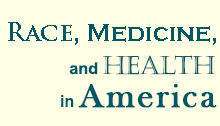Education
Higher Education Module
Race, Medicine, and Health in America
Class 2: Lead Poisoning and the Politics of Uncertainty
Introduction
In the 1920s the automobile and gasoline industry introduced tetraethyl lead into gasoline as a way of reducing engine knocking and increasing engine efficiency. Public health officials warned that exposure from persistent lead in the environment was particularly harmful to young children, and factory workers exposed to lead while producing the additive also suffered. By the 1970s communities living under the shadow of lead-producing industries also created grassroots movements against corporations. The 1920s also witnessed the emergence of paint in American households; roughly seventy-percent of the stock containing pigments of lead. In the midst of advertising campaigns by lead companies attempting to assure consumers of lead’s safety public health officials, politicians, and scientists slowly began making efforts to reduce levels of lead in the environment. By the end of the 1990s lead products were banned from gasoline and paint products. Nonetheless, a critical public health dilemma remained; particularly what to do with the millions of poor people still living in public housing and exposed to lead-based paint on a daily basis. Throughout the 20th century pro-lead public health and industry officials also produced information to counter the wealth of reports describing lead’s many dangers, ultimately creating a mountain of scientific uncertainty around whether lead should be discontinued in products. The readings by Gerald Markowitz, David Rosner, Monica Perales, and John Wargo place toxic contamination and the creation of doubt around lead poisoning within the context of other environmental and health dilemmas such as the tobacco industry, toxic hormone disruptors, and pesticides.
Class Resources
Readings
Markowitz, Gerald and David Rosner. Lead Wars: The Politics of Science and the Fate of America’s Children. Berkeley: University of California Press, 2013, pp. 1-43; 145-231
Wargo, John. Our Children’s Toxic Legacy: How Science and Law Fail to Protect Us From Pesticides. New Haven, CT: Yale University Press, 1998, pp. 251-289.
Perales, Monica. Smeltertown: Making and Remembering a Southwest Border Community. Chapel Hill: University of North Carolina Press, 2010, 1-17; 226-279.
Additional online resources
National Library of Medicine. “Lead Poisoning.” Visual Culture and Public Health Posters. Available online at https://profiles.nlm.nih.gov/spotlight/vc
Discussion Questions:
- What was the Dutch Boy advertising campaign described in the Markowitz and Rosner book, and how did it influence the history of lead in the 20th century?
- How familiar are you with the dangers of lead poisoning today? What are the ways in which you might still be surrounded by lead in your current environment?
- Based on Wargo’s argument of “fractured laws and fractured science,” why do you think information about lead’s dangers remained hidden for so long when evidence of lead’s subclinical dangers have been understood for over a century?
- In what ways do Markowitz and Rosner tie the Kennedy Krieger Research Study conducted by Johns Hopkins University to the Tuskegee Syphilis Study?
- What do you think is the future of lead poisoning? Is it fiscally possible to remove lead from the entire nation’s housing stock and other environments? What does this say about where and how people live in the 21st century?
- Smeltertown describes lead exposure through the lens of a Southwest Texas border town where toxic air emissions from the American Smelting and Refining Company created health problems for residents. What are some of the ways in which residents might raise the awareness of air emissions and lead poisoning in the environment?


